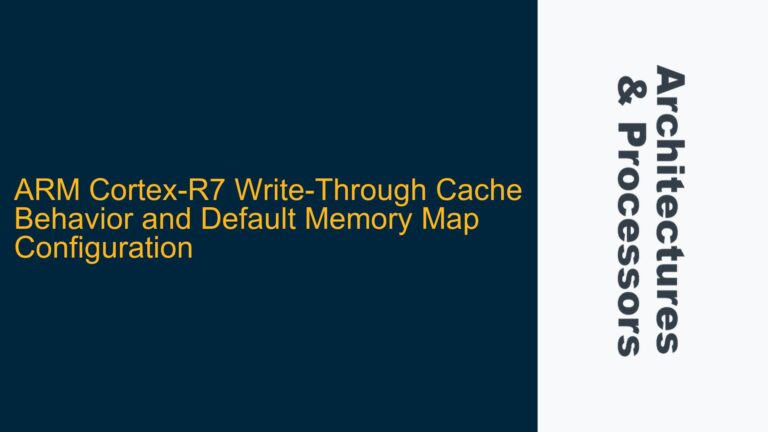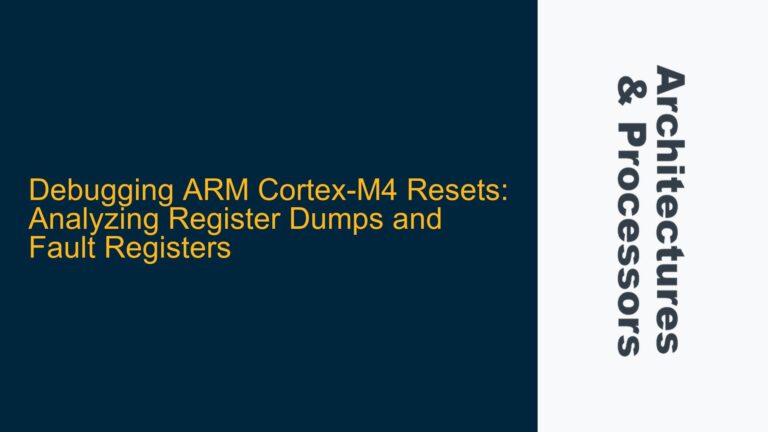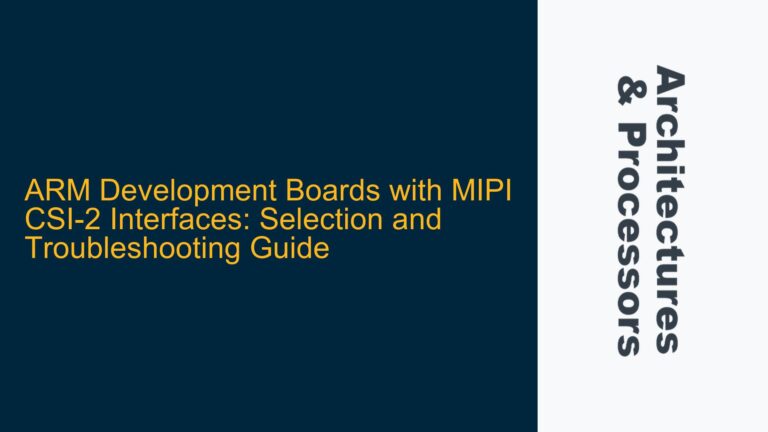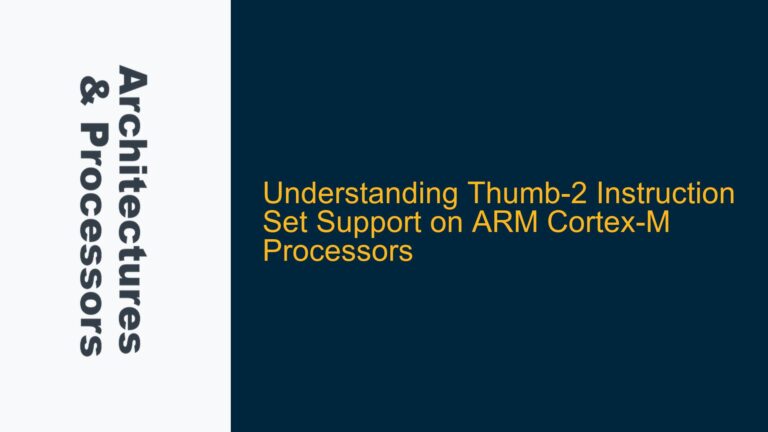ARM Cortex-M Memory Alignment Challenges with 24-Bit Data Structures
When working with ARM Cortex-M processors, such as the STM32 series, one of the most common challenges developers face is handling data structures that do not align neatly with the processor’s native word sizes. The Cortex-M series, including the M0, M3, and M4, is designed to efficiently handle 8-bit, 16-bit, and 32-bit data types. However, when dealing with 24-bit signed integers, the lack of direct support for this data size introduces complications in memory alignment, data storage, and retrieval.
The ARM architecture enforces strict alignment rules for memory access. For instance, 32-bit words must be aligned to 4-byte boundaries, and 16-bit halfwords must be aligned to 2-byte boundaries. These rules ensure optimal performance and prevent hardware exceptions. However, 24-bit integers, which occupy 3 bytes, do not align naturally with these boundaries. This misalignment can lead to inefficiencies, such as requiring multiple memory accesses to read or write a single 24-bit value, or even causing alignment faults if not handled correctly.
In the context of initializing an array of 16 elements, each being a 24-bit signed integer, the challenge is compounded. The array must be stored in memory in a way that respects the alignment constraints of the processor while ensuring that each element can be accessed efficiently. This requires careful consideration of memory layout, instruction selection, and potential trade-offs between code size, execution speed, and memory usage.
Misaligned Memory Access and Instruction Set Limitations
The root cause of the difficulty in handling 24-bit integers lies in the combination of misaligned memory access and the limitations of the ARM Thumb-2 instruction set. The Thumb-2 instruction set, used by Cortex-M processors, provides a compact and efficient set of instructions but lacks direct support for 24-bit data manipulation. This forces developers to use a combination of 16-bit and 8-bit instructions to handle 24-bit values, which can lead to inefficiencies and potential errors.
For example, storing a 24-bit integer requires splitting the value into a 16-bit halfword and an 8-bit byte. The 16-bit halfword can be stored using the STRH (Store Register Halfword) instruction, while the remaining 8 bits can be stored using the STRB (Store Register Byte) instruction. However, this approach introduces several challenges:
- Alignment Issues: If the 24-bit integer is not aligned to a 2-byte boundary, storing the 16-bit halfword using
STRHmay result in an alignment fault. This is particularly problematic when initializing an array, as the alignment of each element depends on its position within the array. - Instruction Overhead: Splitting the 24-bit value into two parts and storing them separately increases the number of instructions required, which can impact both code size and execution speed.
- Data Integrity: Care must be taken to ensure that the 16-bit and 8-bit parts of the 24-bit integer are stored and retrieved correctly, especially when dealing with signed integers where the sign bit must be preserved.
Additionally, the Cortex-M0 processor, which is based on the ARMv6-M architecture, has even more limited instruction support compared to the Cortex-M3 and M4. This further complicates the task, as developers must ensure that their code is compatible with the target processor’s instruction set.
Efficient Memory Layout and Instruction-Level Optimizations
To address the challenges of initializing an array of 24-bit signed integers on an STM32 microcontroller, developers can employ a combination of efficient memory layout strategies and instruction-level optimizations. The goal is to minimize alignment issues, reduce instruction overhead, and ensure correct handling of signed integers.
Memory Layout Strategies
One effective approach is to store the 24-bit integers in a packed format, where each element occupies exactly 3 bytes. This avoids wasting memory but requires careful handling of alignment. To mitigate alignment issues, the array can be placed at a memory address that is aligned to a 4-byte boundary. This ensures that the first element is aligned, and subsequent elements can be accessed using offsets that respect the 3-byte alignment.
For example, consider the following memory layout for an array of 16 24-bit integers:
| Address Offset | Data (Bytes) |
|---|---|
| 0x0000 | Byte 0, Byte 1, Byte 2 (Element 0) |
| 0x0003 | Byte 3, Byte 4, Byte 5 (Element 1) |
| 0x0006 | Byte 6, Byte 7, Byte 8 (Element 2) |
| … | … |
| 0x002D | Byte 45, Byte 46, Byte 47 (Element 15) |
By aligning the start of the array to a 4-byte boundary, the first element is guaranteed to be aligned. Subsequent elements are accessed by calculating the appropriate offset, ensuring that the 16-bit halfword is always aligned to a 2-byte boundary within the 3-byte element.
Instruction-Level Optimizations
To store a 24-bit integer, the value can be split into a 16-bit halfword and an 8-bit byte. The 16-bit halfword is stored using the STRH instruction, and the 8-bit byte is stored using the STRB instruction. The following example demonstrates how to initialize an array of 16 24-bit signed integers in ARM assembly:
.data
.align 4
array:
.space 48 ; Reserve space for 16 elements (16 * 3 bytes)
.text
.global _start
_start:
LDR R0, =array ; Load base address of the array
LDR R1, =0x123456 ; Example 24-bit value (lower 16 bits: 0x3456, upper 8 bits: 0x12)
MOV R2, #16 ; Number of elements
init_loop:
STRH R1, [R0], #2 ; Store lower 16 bits and increment address by 2
LSR R3, R1, #16 ; Shift upper 8 bits into position
STRB R3, [R0], #1 ; Store upper 8 bits and increment address by 1
SUBS R2, R2, #1 ; Decrement element count
BNE init_loop ; Repeat for all elements
; End of initialization
In this example, the STRH instruction stores the lower 16 bits of the 24-bit integer, and the STRB instruction stores the upper 8 bits. The address is incremented by 2 after storing the 16-bit halfword and by 1 after storing the 8-bit byte, ensuring that each element is stored correctly in memory.
Handling Signed Integers
When dealing with signed 24-bit integers, care must be taken to preserve the sign bit during storage and retrieval. The sign bit is located in the most significant bit (MSB) of the 24-bit integer. To ensure correct handling, the upper 8 bits must be sign-extended when loading the value from memory. This can be achieved using the SXTB (Sign Extend Byte) instruction, which extends the sign bit of an 8-bit value to fill the upper bits of a 32-bit register.
For example, to load a 24-bit signed integer from memory:
LDRH R1, [R0], #2 ; Load lower 16 bits and increment address by 2
LDRB R2, [R0], #1 ; Load upper 8 bits and increment address by 1
SXTB R2, R2 ; Sign-extend the upper 8 bits
LSL R2, R2, #16 ; Shift the sign-extended bits to the upper 16 bits
ORR R1, R1, R2 ; Combine the lower 16 bits and upper 8 bits
This approach ensures that the sign bit is correctly preserved when loading a 24-bit signed integer from memory.
Alternative Approaches
While the above method is effective, it may not be the most efficient in terms of code size and execution speed, especially on processors with limited instruction sets like the Cortex-M0. An alternative approach is to use two separate arrays: one for the lower 16 bits of each element and another for the upper 8 bits. This eliminates alignment issues and simplifies the storage and retrieval process, at the cost of increased memory usage.
For example:
.data
.align 4
array_low:
.space 32 ; Reserve space for 16 elements (16 * 2 bytes)
array_high:
.space 16 ; Reserve space for 16 elements (16 * 1 byte)
.text
.global _start
_start:
LDR R0, =array_low ; Load base address of the lower 16-bit array
LDR R1, =array_high ; Load base address of the upper 8-bit array
LDR R2, =0x123456 ; Example 24-bit value (lower 16 bits: 0x3456, upper 8 bits: 0x12)
MOV R3, #16 ; Number of elements
init_loop:
STRH R2, [R0], #2 ; Store lower 16 bits and increment address by 2
LSR R4, R2, #16 ; Shift upper 8 bits into position
STRB R4, [R1], #1 ; Store upper 8 bits and increment address by 1
SUBS R3, R3, #1 ; Decrement element count
BNE init_loop ; Repeat for all elements
; End of initialization
This approach simplifies the storage and retrieval of 24-bit integers by avoiding alignment issues and reducing the number of instructions required. However, it requires additional memory to store the two separate arrays.
Conclusion
Initializing an array of 24-bit signed integers on an STM32 microcontroller presents unique challenges due to the ARM architecture’s alignment requirements and the limitations of the Thumb-2 instruction set. By carefully designing the memory layout and employing instruction-level optimizations, developers can overcome these challenges and ensure efficient and correct handling of 24-bit data. Whether using a packed memory layout or separate arrays for the lower and upper bits, the key is to balance code efficiency, memory usage, and alignment constraints to achieve the best possible performance on the target hardware.






